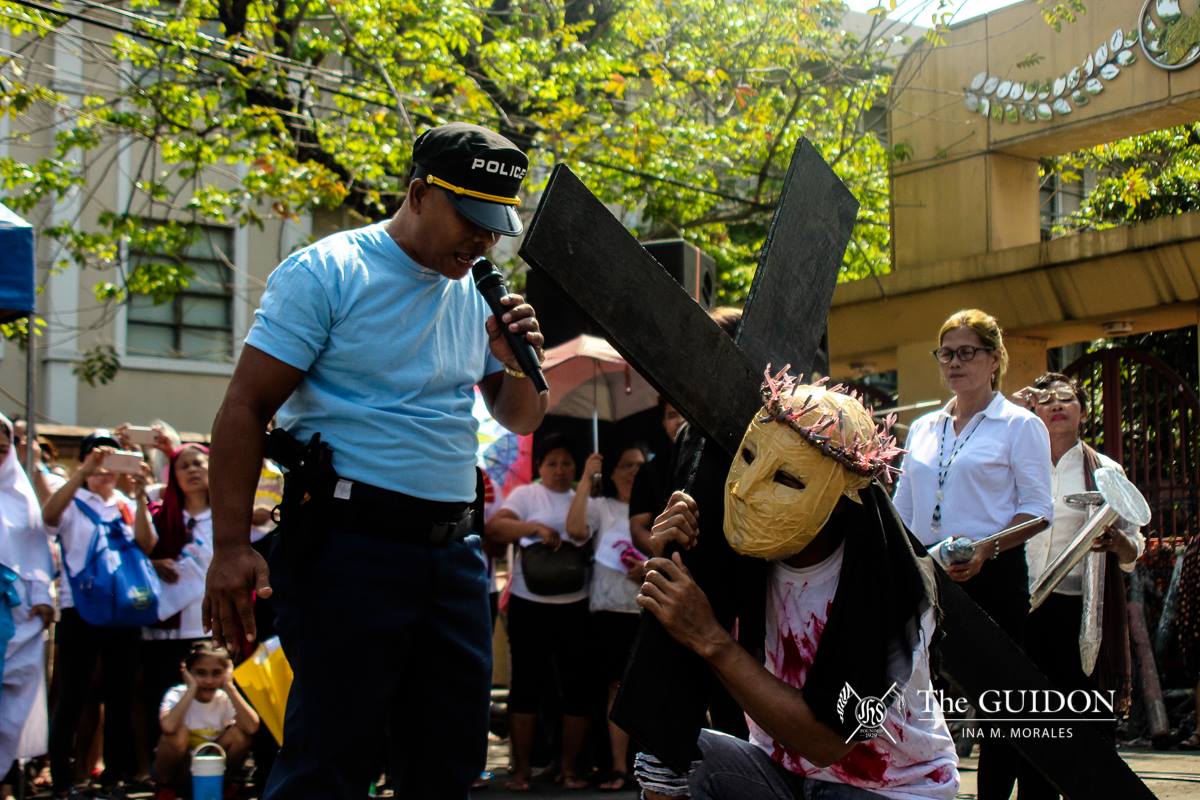WITH THE theme “Patuloy na Paghihirap, Pangamba, at Pagdurusa (Continued hardships, fear, and suffering),” different groups from the urban poor sector staged their annual Kalbaryo (Calvary) last April 11, to call attention to the extrajudicial killings (EJKs) that they say are unfairly targeting their sector.
The street play is an allegory of Jesus Christ carrying his cross on the way to his crucifixion. It is performed annually during the observance of Holy Week.
The groups marched from Plaza Miranda to the Mendiola Peace Arch, where seven actors each carried a cross. A specific issue faced by the urban poor sector was nailed to each cross. Aside from EJKs, the groups protested the lowering of the age of criminal responsibility, uncertainty in the provision of housing and basic services, and the decreasing space for the free and critical participation of the citizenry.President Rodrigo Duterte’s War on Drugs has led to the death of 7,080 since the Duterte administration took over in June 2016. A report released by Amnesty International last February concluded that victims of EJKs, carried out by both policemen and unknown gunmen, came overwhelmingly from the most impoverished sectors of society.
Meanwhile, Human Rights Watch has tagged the Philippine National Police (PNP) in the vigilante-style killings of drug suspects.
Crucifying drug addicts
During the play, actors playing President Duterte or “PDutz,” PNP Chief Ronald dela Rosa or “Batorete,” pro-death penalty congressmen and senators, and “Mochang Angel” persecuted a drug addict, calling him “salot sa lipunan (plague to society)”.
Holding hammers, nails, and syringes, “PDutz” and his allies condemned the drug addict to death by crucifixion, likening the addict to the innocent Jesus Christ.
The drug addict was then labeled as “nanlaban (one who fight back),” a common reason cited by police officers to explain why they shoot and kill suspects during anti-drug operations. The word “nanlaban” was also nailed to the cross.
After being “crucified,” the addict was lowered from the cross and into the arms of a distraught actor playing Mother Mary. “Mary” cries out in despair, asking the crowd if that was the kind of change the people wanted.
Real-life victims
Linda*, who bore a cross during the play, said that the kalbaryo represents the effects the War on Drugs has had on urban poor communities.
Linda shared that her nephew was a former drug addict. She had already surrendered him to their barangay, and was promised that he would only be put in jail. But when she came to visit him the following day, the police officer told her that he had already been killed along with his friend. As if to rub salt on their wound, the funeral parlor asked their family for Php 60,000 to pay for funeral services.
“Pinatay na nga po nila ang aking pamangkin, pinapatay pa nila kami sa gastos sa funerarya (They already killed my nephew, and now they’re killing us with debt),” she laments.
Linda’s story is like many others who have become “collateral damage” in the administration’s War on Drugs. Aside from the vigilante-style killings, added funeral and hospital charges may leave the suspect’s family deeper into poverty.
In the same report by Amnesty International, civil society activists and family members of the deceased have described the War on Drugs as a “war on the poor.”
In an interview with Amnesty International, Rita*, wife of a slain suspect asked why President Duterte was targeting supposed drug pushers with no money to their names. “Why won’t he give them another chance? How about the families left by those killed?”
Another family member of a killed suspect said in an interview, “The small-time users get involved to be able to survive… to have money to feed [their] kids. If you are a big-time user, you are spared. If you are poor, you are killed.”
Added burden
Filomena Cinco, president of the Nagkakaisang Mamamayan ng Legarda, lamented the added burden that the War on Drugs has brought to the already helpless urban poor sector.
“Nakadagdag pa ito [mga EJKs] ulit na nagkaroon pa ng dagdag-kalbaryo kasi sa nangyayari ngayon, karamihan, kalimitan talaga ay mahihirap ‘yung nagiging biktima ng EJK…Dapat patas sa batas ang makukuha namin dahil karamihan nga laging kami ‘yung biktima ng EJK, kung saan walang kalaban-laban ang mga maralitang sektor (EJKs add another burden because today, we see that most victims of the EJK are poor. The law is supposed to be fair to us because most of the time, we, the urban poor, are the victims of EJKs, and are the most helpless),” said Sinco.
Former Department of Social Welfare and Development Secretary Dinky Soliman, who attended the event, said that in the War on Drugs, it is the poor that are being killed.
She said that if more people were unafraid of speaking up and calling out these injustices, perhaps the administration would finally heed the cry of the urban poor.
“[We can get the current administration to pay attention to this issue] by more people speaking up, by more people not afraid, by more people not disturbed, by more people saying it is not right. I think they are not disturbed because they are afraid, number one, and second, there are people who have been poisoned with the thinking that these poor people deserve to die, and I really protest that,” said Soliman.
*Names withheld to protect their identity.




